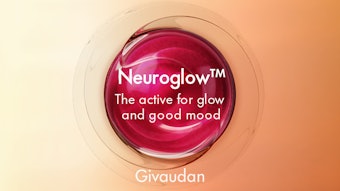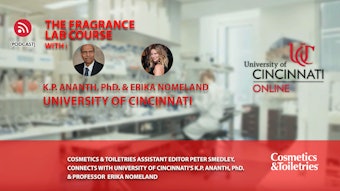See the Digital Magazine for the complete article.
Prolonging the degradation and volatilization of fragrances is key to creating personal care products with extended and balanced sensory stimuli. Encapsulation is a widely used approach for controlling the delivery of sensory compounds and other active ingredients. In addition to altering the rate of fragrance vaporization, encapsulation can be beneficial for formulations where the volatile compound(s) are insoluble in a suitable solvent system.
Various encapsulation technologies have been developed, including entrapment within polymer systems,1-3 molecular inclusion in a host such as cyclodextrin,4 absorption into silica microspheres5 and co-addition to various emulsified fluids prepared via coacervation.6, 7 Another is the loading of active ingredients into polymers via interfacial polymerization or in situ polymerization.8 The fundamental principle of delivery is to limit the rate of fragrance diffusion through hindered mass transport. Binding the fragrance to a surface or host may also play an important role in reducing volatility and extending the sensory characteristics of the product; this has been explored by some.9 Regardless of the approach, fragrances must be chemically inert to be encapsulated by most mechanisms, especially those that use active polymerization routes to entrap solutes.
The stimulated release and increase in delivery of fragrances during physiological or environmental changes is also a mechanism of interest. In relation, chemistries have been developed that link pro-fragrance molecules to a solid support through a liable covalent bond.10 Without a stimulus, the pro-fragrance is incapable of being volatized by the covalent bond linkage; however, bond breakage and volatilization of the fragment can be induced by light,11 heat,12 hydrolysis,13 changes in pH14 or the activity of enzymes.15 A drawback to chemical bond cleavage and delivery is the limited number of mild reactions and pro-fragrances that are available. Also, careful packaging is necessary to extend shelf-life of the inherent reactive pro-fragrance systems. Further research is needed to optimize delivery systems, increase the number of simultaneously released fragrances, and reduce the need for expensive raw material stocks.
Other options for potential fragrance delivery are animated materials that can change their physical properties as a function of a stimulus. Hydrogels, which can swell with water, are the most common example of such materials, changing their porosity to deliver an active ingredient.16, 17 Through careful control of their chemistry, hydrogels can be made to be thermally reversible18, 19 or pH-responsive.20, 21 Silica-based solids typically are characterized as inelastic and not swellable, with only rare exceptions.22, 23 For other materials, a modest degree of swelling has been reported, typically < 15% of their initial volume, based on some type of physical or chemical change; for example, a change in temperature or pH. Described here is a chemically inert nanoporous organosilicaa that is designed to rapidly (< 1 sec) swell up to four times its volume and eight times it mass with organic solvents. Here, the author evaluates its capabilities for the extended release of volatile fragrances and the stimulated release of active ingredients.










